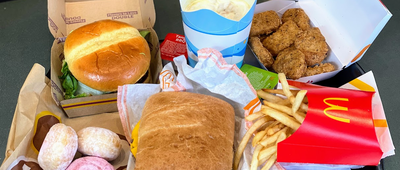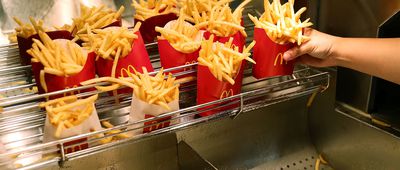If you're a fan of McDonald's crisp, golden French fries, you've likely wondered if something changed about the flavor of those world-famous fries over the years — rest assured, you're not alone in your suspicions. Over the decades, the fast-food giant has changed the oil used to cook those signature fries, often in response to public pressure for a "healthier" French fry, resulting in a product that many swear doesn't taste quite as good as it once did (not that we've stopped eating them, mind you). To understand what changed, we decided to explore why McDonald's French fries used to taste a lot better.
A Franchise Founded on Fries
To better understand how McDonald's fries changed over the years, we have to go back to the early golden years of the Golden Arches. As much as a burger may come to mind when you think of McDonald's, it was really the restaurant's French fries that were the main attraction from the beginning. At their drive-in hamburger stand in San Bernardino, California, brothers Dick and Mac McDonald drew big crowds for fries, burgers, and shakes with cheap prices and quick service, beginning in 1940.
It was the restaurant's fries, in particular, that caught the attention of Ray Kroc, who would go on to bring the McDonald's franchise to the world. "The McDonald's French fry was in an entirely different league," Kroc explains in his memoir, "Grinding It Out: The Making of McDonald's." "They lavished attention on it. I didn't know it then, but one day I would, too. The French fry would become almost sacrosanct for me, its preparation a ritual to be followed religiously."
Taking Time to Make Fries

Two major factors made those original French fries irresistible: texture and tallow. Kroc realized quickly that what helped keep McDonald's fries from getting mushy after the frying process was maintaining the right amount of moisture and starch in the fries. Even the reliable Russet Burbank potato — the large, oblong variety that McDonald's uses to this day among others — can vary in moisture content depending on where and how it's grown. To maintain consistency, Kroc had suppliers use hydrometers to ensure optimal moisture content.
Kroc also found that curing the potatoes — storing them in warm temperatures for a few weeks — helped convert the sugars in a fresh potato into starch, which made for a crisper fry that didn't caramelize and brown. He also hired an electrical engineer named Louis Martino to develop a "potato computer" to determine the optimal cooking time for the fries. But it was the beef tallow used to cook the fries that ultimately made them a worldwide hit.
Beef Tallow: The Cheaper Alternative
 The tallow was used initially because it was the cheap, convenient option. Interstate, the fry oil supplier for the McDonald brothers' burger stand, was too small of an operation to afford the expensive hydrogenation equipment to produce partially hydrogenated vegetable oil — the most popular frying oil at the time.
The tallow was used initially because it was the cheap, convenient option. Interstate, the fry oil supplier for the McDonald brothers' burger stand, was too small of an operation to afford the expensive hydrogenation equipment to produce partially hydrogenated vegetable oil — the most popular frying oil at the time.
Instead, Interstate provided McDonald's with a blend of 7% vegetable oil and 93% beef tallow, sourced from the stockyards of Chicago, which could extend the life of the oil without expensive equipment. It also happened to make the fries incredibly delicious.
The Flavor Secrets of Formula 47
The special beef tallow and oil blend for McDonald's fries became known as Formula 47, named after the combined cost of the restaurant's "All-American meal" at the time, which included a 15-cent burger, 12-cent fries, and a 20-cent shake.
Kroc insisted that all of the McDonald's franchises use Formula 47, ensuring that the rest of the country — and eventually the world — would come to love the taste of McDonald's French fries.
In his memoir, Kroc explains how important those fries were to the success of McDonald's, "One of my suppliers told me 'Ray, you know you aren't in the hamburger business at all. You're in the French-fry business. I don't know how the livin' hell you do it, but you've got the best French fries in town, and that's what's selling folks on your place.'" He goes on to say, "The quality of our French fries was a large part of McDonald's success."
A Change of Heart
The buttery, beef tallow flavor would continue to be a hallmark of McDonald's fries for decades, adored by the millions — and later billions — served. But eventually, concerns were raised that the saturated fat in beef tallow raises cholesterol levels to potentially dangerous heights, which eventually prompted a change in the recipe.
In 1966, self-made millionaire Phil Sokolof had a nearly life-ending heart attack at age 43, prompting him to create the National Heart Savers Association to campaign against fat and cholesterol in the American diet. A self-admitted "student in the greasy hamburger school of nutrition" before his heart attack, Sokolof went on to launch a multimillion-dollar campaign, including full-page newspaper ads, contending that McDonald's and other fast-food chains were threatening lives with high-cholesterol menus.
In 1990, faced with Sokolof's campaign and growing public concerns about health, McDonald's gave in. Beef tallow was eliminated from the world-famous French fry formula and replaced with 100% vegetable oil. The results were French fries with zero cholesterol and 45% less fat per serving than before, but also a plummet in stock prices and countless consumers saddened by a drop in flavor.
Trying to Bring Back the Flavor
To bring back some of the flavor lost by removing beef tallow, McDonald's began adding "beef flavoring" to its fries. But the company was forced to settle lawsuits from vegetarians and Hindus who abstain from eating beef for not disclosing the added ingredient. The company now lists "natural beef flavor," of which the starting ingredients are hydrolyzed wheat and milk proteins thought to be a source of "meaty-tasting" amino acids. Many customers thought the changes lost much of the fries' balance between a crisp, crunchy exterior and a soft interior.
![Oil Change]() Oil Change
Oil Change
To make matters worse, the new oil blend began raising health concerns of its own as people became aware of the risks posed by trans fats in hydrogenated vegetable oil. So in 2002 the company changed the formula again to a new soy-corn oil, designed to cut the amount of trans fats by half while increasing the amount of healthy polyunsaturated fats. In 2007, McDonald's announced yet another new oil blend for its fries, this time a healthier trans-fat-free oil — in part a response to New York City's ban on trans fats.
Healthier But Still Delicious
So while the McDonald's French fry may be healthier than it was decades ago, we may have sacrificed a lot of taste along the way. Of course, many of us still enjoy McDonald's French fries, perhaps just not as much as we used to. The fries still have that golden, crispy exterior and tender interior. They still offer that delicious sweet-salty combo, thanks to a spray of dextrose after they've been blanched during processing, and the salt sprinkled on after frying.
Testing the Original Recipe
For those wondering if we remember the original version of McDonald's fries as better tasting only because of nostalgia, author Malcolm Gladwell dispels that idea in his "Revisionist History" podcast episode, "McDonald's Broke My Heart." In the podcast, Gladwell laments the end of beef tallow use in 1990. He even goes so far as to have the country's leading food scientists recreate the original recipe for a taste test against the modern ones. It's no contest, the original recipe wins, and Gladwell concludes, "My heart is full of sadness again to think about how many millions and millions and millions of people around the world have never tasted that."
If you'd like to do a taste test yourself, you may want to try making a batch of fries with the original beef tallow recipe.

 Oil Change
Oil Change






